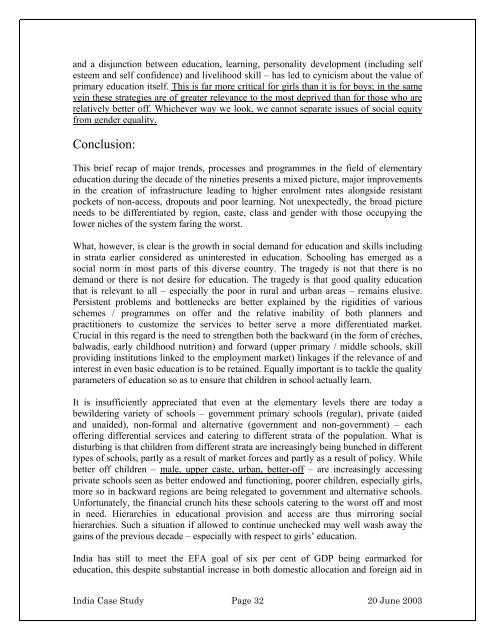Where are we today with respect to girls' education
Where are we today with respect to girls' education
Where are we today with respect to girls' education
- No tags were found...
You also want an ePaper? Increase the reach of your titles
YUMPU automatically turns print PDFs into web optimized ePapers that Google loves.
and a disjunction bet<strong>we</strong>en <strong>education</strong>, learning, personality development (including selfesteem and self confidence) and livelihood skill – has led <strong>to</strong> cynicism about the value ofprimary <strong>education</strong> itself. This is far more critical for girls than it is for boys; in the samevein these strategies <strong>are</strong> of greater relevance <strong>to</strong> the most deprived than for those who <strong>are</strong>relatively better off. Whichever way <strong>we</strong> look, <strong>we</strong> cannot separate issues of social equityfrom gender equality.Conclusion:This brief recap of major trends, processes and programmes in the field of elementary<strong>education</strong> during the decade of the nineties presents a mixed picture, major improvementsin the creation of infrastructure leading <strong>to</strong> higher enrolment rates alongside resistantpockets of non-access, dropouts and poor learning. Not unexpectedly, the broad pictureneeds <strong>to</strong> be differentiated by region, caste, class and gender <strong>with</strong> those occupying thelo<strong>we</strong>r niches of the system faring the worst.What, ho<strong>we</strong>ver, is clear is the growth in social demand for <strong>education</strong> and skills includingin strata earlier considered as uninterested in <strong>education</strong>. Schooling has emerged as asocial norm in most parts of this diverse country. The tragedy is not that there is nodemand or there is not desire for <strong>education</strong>. The tragedy is that good quality <strong>education</strong>that is relevant <strong>to</strong> all – especially the poor in rural and urban <strong>are</strong>as – remains elusive.Persistent problems and bottlenecks <strong>are</strong> better explained by the rigidities of variousschemes / programmes on offer and the relative inability of both planners andpractitioners <strong>to</strong> cus<strong>to</strong>mize the services <strong>to</strong> better serve a more differentiated market.Crucial in this regard is the need <strong>to</strong> strengthen both the backward (in the form of crèches,balwadis, early childhood nutrition) and forward (upper primary / middle schools, skillproviding institutions linked <strong>to</strong> the employment market) linkages if the relevance of andinterest in even basic <strong>education</strong> is <strong>to</strong> be retained. Equally important is <strong>to</strong> tackle the qualityparameters of <strong>education</strong> so as <strong>to</strong> ensure that children in school actually learn.It is insufficiently appreciated that even at the elementary levels there <strong>are</strong> <strong><strong>to</strong>day</strong> abewildering variety of schools – government primary schools (regular), private (aidedand unaided), non-formal and alternative (government and non-government) – eachoffering differential services and catering <strong>to</strong> different strata of the population. What isdisturbing is that children from different strata <strong>are</strong> increasingly being bunched in differenttypes of schools, partly as a result of market forces and partly as a result of policy. Whilebetter off children – male, upper caste, urban, better-off – <strong>are</strong> increasingly accessingprivate schools seen as better endo<strong>we</strong>d and functioning, poorer children, especially girls,more so in backward regions <strong>are</strong> being relegated <strong>to</strong> government and alternative schools.Unfortunately, the financial crunch hits these schools catering <strong>to</strong> the worst off and mostin need. Hierarchies in <strong>education</strong>al provision and access <strong>are</strong> thus mirroring socialhierarchies. Such a situation if allo<strong>we</strong>d <strong>to</strong> continue unchecked may <strong>we</strong>ll wash away thegains of the previous decade – especially <strong>with</strong> <strong>respect</strong> <strong>to</strong> girls’ <strong>education</strong>.India has still <strong>to</strong> meet the EFA goal of six per cent of GDP being earmarked for<strong>education</strong>, this despite substantial increase in both domestic allocation and foreign aid inIndia Case Study Page 32 20 June 2003












